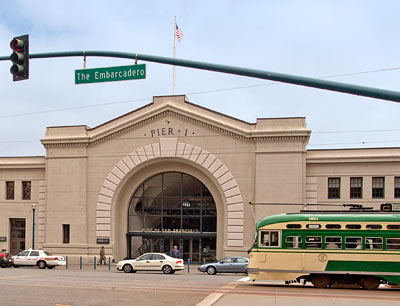National Register of Historic Places in San Francisco
Pier One
The Embarcadero At Washington
Built 1931
In 1915, the California State Board of Harbor Commissioners issued a master plan for The Embarcadero and the waterfront, a plan inspired by the City Beautiful movement. Pier One, built in 1931 was one of the last buildings completed under the plan.
Pier One is a finger pier. Of the forty-nine finger piers built, eleven survive.
Finger piers were designed for bulkbreak traffic - freight broken into small crates that could be easily loaded and unloaded from ships by laborers. Bulkbreak traffic, which persisted until the second quarter of the 20th century, gave way to container shipping where cargo was loaded and trucked in massive crates, and later sealed metal containers, to waterfronts that could accommodate ocean going vessels.
Container shipping requires large, flat expanses of wharf space, cranes to lift containers into ships and deep channels to accommodate oceangoing vessels. Most of San Francisco's finger piers lack all of these features. Innovations in cargo handling, causing a shift from bulkbreak to containerized freight, made finger piers obsolete after about the mid-1940s.
Wartime expansion of the three railroads in the Bay Area with transcontinental links - the Southern Pacific, the Western Pacific and the Santa Fe - provided adequate rail connections for the Belt Line Railway serving the Port of San Francisco. Truck service was not adequate, however, because the transit sheds, like the Pier One shed, were designed for rail traffic rather than truck traffic. Inadequate trucking facilities dockside exacerbated the obsolescence of the finger piers.
Extracted from the NRHP nomination form.

The San Francisco waterfront, like the San Francisco Civic Center (NRHP Listing #78000757), was inspired by the City Beautiful Movement: a grand boulevard lined with a harmonious ensemble of monumental, neo-classical, public buildings funded by a State agency.

Pier One contributes to two NRHP Historic Districts, the Port of San Francisco Embarcadero Historic District and the Central Embarcadero Piers Historic District.
